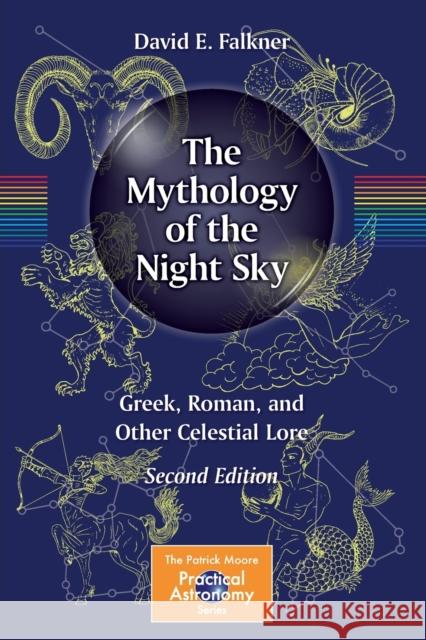The Mythology of the Night Sky: Greek, Roman, and Other Celestial Lore » książka



The Mythology of the Night Sky: Greek, Roman, and Other Celestial Lore
ISBN-13: 9783030476939 / Angielski / Miękka / 2020 / 331 str.
The Mythology of the Night Sky: Greek, Roman, and Other Celestial Lore
ISBN-13: 9783030476939 / Angielski / Miękka / 2020 / 331 str.
(netto: 126,19 VAT: 5%)
Najniższa cena z 30 dni: 115,63
ok. 22 dni roboczych
Dostawa w 2026 r.
Darmowa dostawa!
This book is for amateur astronomers who would like to know the mythology behind the names of astronomical objects in the night sky.
"This book is a worthy addition to the literature on the names of heavenly bodies, and can be recommended." (Robert Connon Smith, The Observatory, Vol. 141 (1282), June, 2021)
Contents
1 An Introduction to Greco-Roman Mythology
The Night Sky and Ancient Cultures Greek or Roman?The Creation of the World
Astronomical Family Trees2 The Winter Constellations
Orion – The HunterCanis Major – The Great Dog
Canis Minor – The Little Dog Lepus – The HareScorpius – The Scorpion
Taurus – The Bull The Hyades – The Daughters of AtlasThe Pleiades (M45) – The Seven Sisters
Auriga – The Charioteer Eridanus – The River Aries – The RamGemini – The Twins
The Ship Argo
Puppis – The Stern Pyxis – The Mariner’s CompassVela – The Sails
Carina – The Keel3 The Legend of Jason and the Argonauts
The Constellations
The Legend4 The Spring Constellations
Ursa Major and Ursa Minor – The Greater Bear and the Lesser Bear
Ursa Major – The Great Bear and the Big Dipper Ursa MinorBoötes – The Herdsman (or the Plowman)
Virgo – The Virgin Corvus – The CrowCrater – The Cup
Centaurus – The Centaur
Lupus – The Wolf Leo – The LionHydra – The Watersnake
Cancer – The Crab
5 The Summer Constellations
Ophiuchus – The Serpent-BearerSerpens (Cauda and Caput) – The Serpents
Corona Borealis – The Northern CrownCorona Australis – The Southern Crown
Draco – The Dragon Aquila – The Eagle Scorpius – The ScorpionLibra – The Scales
Sagittarius – The Archer Lyra – The Lyre Cygnus – The SwanAra – The Altar
Hercules – The Hero Sagitta – The Arrow Equuleus – The Foal6 The Legend of Hercules
The Constellations The Legend7 The Autumn Constellations
Delphinus – The Dolphin
Aquarius – The Water-Bearer Capricornus – The Sea-GoatPisces – The Fishes
Pisces Austrinus – The Southern Fish Pegasus – The Flying HorseAndromeda – The Princess
Cetus – The Sea-Monster (Whale) Cassiopeia – The QueenCepheus – The King
Perseus – The Hero Triangulum – The Triangle8 The Legend of Perseus
The Constellations
The Legend9 Introductions to Other Mythologies
Norse Mythology
Celtic Mythology
Inuit Mythology
Hawaiian Mythology
Rapa Nui Mythology
Tongva Mythology
10 Planets and Satellites
Mercury
Venus Earth Earth’s Satellite – The Moon MarsMars’ Satellites
Jupiter Jupiter’s SatellitesSaturn
Saturn’s SatellitesUranus
Uranus’ SatellitesNeptune
Neptune’s Satellites11 Dwarf Planets and Asteroids
The Dwarf Planets
Ceres
Pluto
Eris
Haumea
Makemake
Sedna
Quaoar
Orcus
The Asteroids
Vesta (4 Vesta)
Pallas (2 Pallas)
Ceres (1 Ceres)
Iris (7 Iris)
Eros (433 Eros)
Hebe (6 Hebe)
Juno (3 Juno)
Melpomene (18 Melpomene)
Eunomia (15 Eunomia)Flora (8 Flora)
12 Astrophotography Using a Compact Digital Camera or Smartphone Camera
Introduction to Digital Cameras
Astrophotography Using a Compact Digital Camera
Astrophotography Using a Smartphone Camera
Author’s Final Word
Appendices
Appendix A Names of the Greek and Roman GodsAppendix B Ptolemy’s Constellations
Appendix C The Messier Objects
Appendix D NGC/IC Objects by ConstellationAppendix E The Greek Alphabet
Bibliography
IndexDavid Falkner first became interested in Astronomy as a pre-teen when his father took him to a show at the Holcolm Planetarium in Indianapolis, IN. He became hooked and has loved astronomy ever since. When he was a teenager he inherited a home-made Newtonian telescope that needed the primary mirror. He ground a 6” mirror and completed his first telescope, which gave him years of pleasure observing the heavens. In 1973 David joined the US Navy and became an officer in 1980. In 1986 as a Naval Officer stationed in Monterey, California he was involved with the Friends of MIRA (Monterey Institute for Research in Astronomy) where he conducted outreach to local schools associated with the return of Halley’s Comet. David retired from the US Navy in 1993 and settled in Minnesota where he continues his love of astronomy. He has taught introductory Astronomy at a local community college and does extensive astronomy outreach both a NASA Solar System Ambassador and as President of the Minnesota Astronomical Society.
This book is for amateur astronomers who would like to know the mythology behind the names of astronomical objects in the night sky. It covers the lore and legend behind Ptolemy’s 48 constellations, along with significant asterisms, the planets and their moons, the brightest named asteroids and dwarf planets.
The revised second edition includes a host of new moons and dwarf planets discovered since 2011. In addition, it now features a new section on major asteroids and their associated myths. While still primarily focused on Greco-Roman mythology, the book now branches out to cover more recently named objects from other cultures, such as Hawaiian, Rapanui, Tongva and Inuit.
To assist practical observers, the book gives the location and description of each constellation, including named stars and deep-sky objects. A host of helpful astronomy tips and techniques, as well as a brief introduction to astrophotography, is included to encourage direct observation and imaging of these mythical objects in the night sky.
1997-2025 DolnySlask.com Agencja Internetowa
KrainaKsiazek.PL - Księgarnia Internetowa









